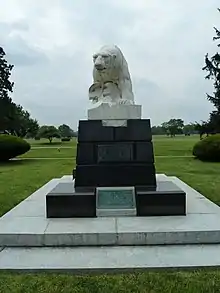White Chapel Memorial Cemetery
White Chapel Memorial Cemetery or simply White Chapel Cemetery is a memorial cemetery at 621 West Long Lake Road in Troy, Oakland County, Michigan. In the 1920s, a group of investors led by Clarence J. Sanger had a new vision for a cemetery and proposed their idea to Detroit architect Alvin Harley. After viewing Harley's initial designs, Sanger urged him to make them more grand. Construction began in 1925 and the cemetery began operation in 1929.[1] Harley's plan created a long central boulevard flanked by rectangular sections extending from the main gate. The boulevard ends at a two-story T-shaped mausoleum faced in white marble, set on a white marble base. Above the central entrance is a square two-story tower which houses a grand hall. Directly behind the hall is one of three chapels in the structure. Crypts are housed in wings extending to the east and west of the grand hall.
 Polar Bear Memorial | |
| Details | |
|---|---|
| Established | 1948 |
| Location | 621 West Long Lake Road Troy, Michigan |
| Country | United States |
| Coordinates | 42.58560°N 83.16360°W |
| Type | Cemetery |
| Website | www |
| Find a Grave | White Chapel Memorial Cemetery |
Polar Bear Memorial
The state of Michigan dedicated a memorial on May 30, 1930, honoring the U.S. Army's Polar Bear Expedition. It recognizes the efforts of the American North Russia Expeditionary Force (ANREF) against the Bolshevik Red Army in North Russia during 1918 and 1919.[2] The remains of 56 ANREF soldiers exhumed from Russia were on this occasion re-buried in plots surrounding the Polar Bear Monument by sculptor Leon Hermant.[3][4]
Discrimination
On August 10, 1960, an honorably discharged 66-year-old World War I veteran, George Vincent Nash, was removed from resting alongside his Caucasian wife at the White Chapel Cemetery.[5][6]
The action took place immediately following the graveside service because Nash was a full-blooded Ho-Chunk (also known as Winnebago) or Native American.[7] The explanation was that 40,000 plot owners "had paid for the restriction" for the type of people that could be buried at White Chapel Cemetery.[8] According to the cemetery's officials, corpses had to be at least 75% Caucasian to be buried at White Chapel.[9] The governor, G. Mennen Williams, was concerned about the legality of the cemetery's actions.[10] However, the Michigan state legislatures in both 1961 and 1962, failed to pass bills that would have prohibited cemeteries to discriminate who could be interred in them on the basis of race.[7]
Notable burials
- Jack Adams (ice hockey player)
- Eileen "Terry" Ambrose (actress and model)
- Brace Beemer (radio announcer and actor)
- William S. Broomfield (US Congressman)
- Donald Byrd (musician)
- Russell Clark (member of the John Dillinger gang)
- John DeLorean (engineer and automaker)
- Roy August Fruehauf {president of Freuhauf Trailer Corporation)
- Ebbie Goodfellow (hall of fame professional hockey Player and coach)
- Josephine Hoffa (Wife of Jimmy Hoffa)
- Lee Iacocca (businessman)
- Albert Kahn (architect)
- Jack Kevorkian (American pathologist and euthanasia activist) Plot: Section H, 6178
- Clem Koshorek (baseball player) Plot: Garden of Prayer, Section 638-1
- J. P. McCarthy (radio personality)
- Douglas Ramsay (figure skater)
- Mauri Rose (racecar driver) Garden of Prayer, Section C, Grave #275
- Eero Saarinen (architect)
- Robert Shumard (WWII United States army air corps soldier)
- Murray Van Wagoner (Michigan Governor)
- Bobby Veach (baseball player) Plot: Mausoleum, First Floor, Section #1212
Notes
- "Saturday, December 19, 2015". Troy Historic Village. Retrieved July 4, 2019.
- Sobczak, John (2009). A Motor City year. Wayne State University Press. p. 69. ISBN 978-0-8143-3410-2. Retrieved 18 March 2013.
- "Burials at the Polar Bear Monument, White Chapel Cemetery, Troy, Michigan". 30 May 1930. Retrieved 18 March 2013.
- Sobczak, John (2009). A Motor City year. Wayne State University Press. p. 69. ISBN 978-0-8143-3410-2. Retrieved 18 March 2013.
- Bak, Richard (2010). Boneyards: Detroit under ground. Wayne State University Press. p. 18. ISBN 978-0-8143-3353-2. Retrieved 18 March 2013.
- "Indian Denied Burial; Barred From Cemetery in Detroit Because of Race". The New York Times. 12 August 1960. Retrieved 4 July 2019.
- Fine, Sidney (2000). Expanding the frontiers of civil rights: Michigan, 1948 - 1968. Wayne State University Press. p. 155. ISBN 978-0-8143-2875-0. Retrieved 18 March 2013.
- "RACES: Segregation After Death". Time. 22 August 1960. Retrieved 18 March 2013.
- Fabre, Genevieve; O'Meally, Robert, eds. (1994). History and Memory in African-American Culture. Oxford University Press. p. 132. ISBN 978-0-1953-5924-4. Retrieved 18 March 2013.
- "Indian Denied Burial Gets Military Honors". The Gadsden Times. Associated Press. 13 August 1960. p. 9. Retrieved 18 March 2013.